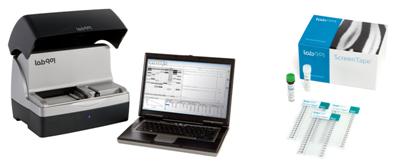Members Login

Channels
Special Offers & Promotions
Lab901

In a recently published paper, Lab901's ScreenTape® automated gel electrophoresis system demonstrated equivalence to - and improvements on - the accepted standard measurement of RNA sample quality control prior to microarray analysis.
The peer-reviewed paper, published in BMC Research Notes,1 set out to evaluate the effectiveness of the ScreenTape Degradation Value (SDV) as a measurement of RNA quality, compared to the Agilent Bioanalyzer's RIN number. The authors concluded that: ‘The ScreenTape platform is comparable to the Bioanalyzer platform in terms of reproducibility and discrimination between different levels of RNA degradation. The robust nature of the SDV metric qualifies it as an alternative metric for RNA sample quality control, and a useful predictor of downstream microarray performance.' The paper went on to show that SDV and RIN scales demonstrated comparable discrimination between differently treated samples, with the SDV exhibiting potentially higher discrimination for more degraded samples, which are often obtained when using biopsies, laser micro-dissected samples or FFPE-treated tissue as the starting material. Increasing SDV values correlated with a decrease in microarray sample labelling efficiency and an increase in numbers of differentially-expressed genes.
Lab901's ScreenTape R6K is a next-generation platform for RNA QC which automatically delivers the ScreenTape Degradation Value (SDV), an objective quality metric for total RNA samples. The ScreenTape system removes steps such as gel reagent prep, chip priming and chip-vortexing, making the electrophoresis much easier and faster. In addition, cross priming and sample carry-over problems are eliminated as ScreenTape R6K uses an individually sealed micro-gel for each sample analysis - improving data quality and reproducibility. Because of this, unlike many chip-based systems, Lab901's ScreenTape device can be used more than once, with researchers able to run as little as one or two samples, reserving the rest of the channels (sixteen in total) for future experiments. Researchers therefore, do not need to batch samples together or throw away unused portions of the consumable, which improves RNA QC workflow and reduces waste as well as cost.
For more information on Lab901's range of ScreenTape products for automated RNA QC, SDS-PAGE and multiplex PCR diagnostics, please visit www.lab901.com.
1. Wilkes T. M., Devonshire A. S., Ellison L. R. andFoy C. A. Evaluation of a novel approach for the measurement of RNA quality. BMC Research Notes 3:89 (2010)
Media Partners


